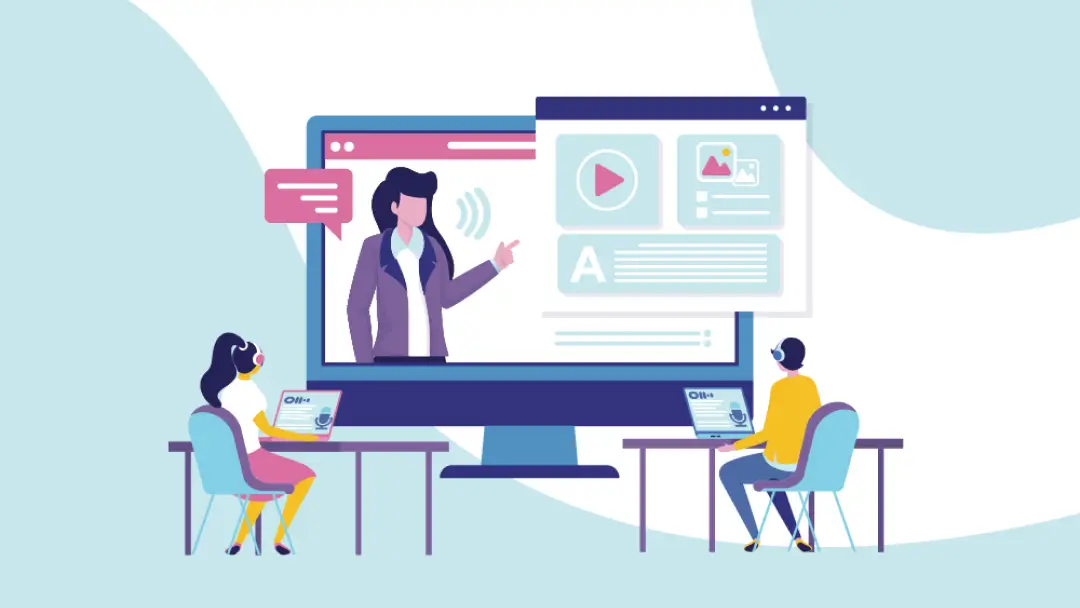Zoom Etiquette for Students: Key Rules for Online Learning

The environments in which students learn are rapidly changing. A few years ago, online classrooms existed, but they were far from commonplace. Now they are the norm in dozens of countries across the globe. COVID-19 has moved millions of learners worldwide from the physical classroom to a virtual one, making Zoom etiquette for students a somewhat new and unexpected topic of importance.
Most aspects of the classroom experience remain the same in person or over the internet, but there are also many unwritten rules of online learning that students should know.
What is Zoom Etiquette for Students?
Just as video meeting etiquette for business professionals has “rules” and expectations, so too does Zoom etiquette for students have its own nuances. In a business meeting, there are a lot of different situations that can arise: pitches to investors, presentations to managers, general team meetings, and so on.
However, most virtual classes have a more predictable structure. One or more instructors leads a group of students through a lecture, discussion, or presentation. Therefore, there is usually specific Zoom etiquette for participants that applies in most virtual learning environments.
However, there is still some variation in rules and expectations based on age and grade level. For example, Zoom etiquette for middle school students and Zoom etiquette for college students are different because behavioral expectations differ. In any case, Zoom etiquette for students all comes down to the best ways for learners to get the most out of a virtual learning environment, while also showing respect to their teachers and fellow students.
But this still begs the question, what is proper Zoom etiquette for students? Fortunately, there are a few broader rules of video conference etiquette that help answer this question and apply to students of all ages:
Internet and Technology
To fully engage in a virtual class, students must have a steady Internet connection, the right equipment, and a basic understanding of how to use video conferencing software like Zoom. Additionally, microphones and headphones should be used to help keep out noisy distractions.
If a student has a poor connection and/or doesn’t know how to join and participate in a virtual class, they will struggle to maintain a productive environment in which to learn. Depending on the age of the student, they may or may not be able to manage the quality of Internet or equipment on their own. In this case, you may need parental guidance or assistance from your instructor.
To fully engage in a virtual class, students must have a steady Internet connection, the right equipment, and a basic understanding of how to use video conferencing software like Zoom.
Video and Webcams

Nearly all virtual classrooms require students to use video technology and webcams. This allows students and teachers to see each other face to face, which can make lectures, presentations, and class discussions more engaging.
Therefore, understanding how to use the video feature in Zoom or other video conferencing tools, as well as the built-in webcam on your device, is vital to ensure that you can be engaged in the classroom. Furthermore, webcams ensure teachers can know whether students are actually attending the classes and paying attention to the lessons.
Location and Background
In addition to a solid Internet connection, students must ensure that their location and background are free of distractions and conducive to a good learning environment. Noise or even visual distractions in the background could inadvertently cause issues for yourself and others. Therefore, it is vital to set up a clean, organized, and distraction-free area to learn and study.
“Set up a dedicated learning environment for studying. By completing your work there repeatedly, you’ll begin to establish a routine. Whether your workspace is your kitchen table, a library, or the corner booth in a local coffee shop, it’s important to determine what type of environment will work best for you. Experiment to discover which type of setting boosts your productivity. Wherever you choose, make sure there’s high-speed internet access so you’re not trying to take an online course over a lagging connection.” [1] - Northeastern University Editorial Staff
Communication
Many students struggle to communicate in person or online. Therefore, when you add in potential issues like sound delays and background noise, it can make it even more difficult to actively participate in discussions or even just ask comprehension questions.
This means that you have to make an extra effort to communicate effectively, whether it’s through talking slowly and clearly, listening intently, or even writing relevant messages in your classroom’s group chat.
Time and Focus
Attending class on time is one of the most important aspects of Zoom etiquette for students. If you frequently show up late or fail to connect to the virtual classroom at all, you could risk completely missing out on vital information. Additionally, there is no point in attending class if you fail to focus on what is being taught. Consequently, paying attention during lectures and class discussions is essential during every virtual session.
Unfortunately, manual notetaking can often make it harder to give 100% of your focus to your instructor and fully participate in class discussions. Thankfully, Otter.ai’s live note transcriptions can improve the quality of learning & listening in remote Zoom class settings, as you can focus on the content of the class instead of struggling to take notes manually. Additionally, auditory impaired students can use Otter.ai to make sure that they absorb all of the information discussed during every lecture.
Zoom Etiquette for Kids (Nursery, Pre-K, & Elementary School)

With young children (ages 3-6), some degree of parental presence and guidance is required. Most children in that age range struggle with sitting still and following instructions, to say nothing of the technical steps required to join a virtual classroom.
Therefore, if your child is in nursery school, Pre-K, Kindergarten, or even the first or second grade of elementary school, you may need to be with your child for the duration of the class. Once your child becomes accustomed to the process, you may be able to take a more “hands-off” approach, but it’s especially crucial to help instill good habits when they are just getting started.
Once your child is a little older (ages 7-11), you can put more of the responsibility on your child to follow the proper Zoom etiquette for students in elementary school, including:
- Being dressed and ready for class in advance
- Connecting to the virtual classroom on their own
- Listening to the teacher’s instructions
- Asking for permission to speak
- Being respectful to everyone in the classroom
- Ignoring background distractions
As you can see, these are some general rules that are good for most students to follow, but they are particularly important for younger children learning the do’s and don’ts of Zoom etiquette. And while this age range will likely allow students to have a little more autonomy, you (as a parent) will still likely need to help your child with some of the technical aspects of online learning.
Zoom Etiquette for Middle & High School Students
Nowadays, pre-teens and teenagers are relatively well-versed in the technology required to make, join, and participate in video calls. However, this doesn’t mean that they will know exactly how to prepare for a Zoom class or behave properly while it is in session. In fact, behavioral problems can be just as prevalent (if not more so) among students between grades 6 to 12.
“A lot of times, defiance is about seeking control. We see more bids for control from kids when things seem uncertain and out of control, like they do now. This can show up as an increased need for students to feel like they are ‘in charge’ of their lives, and sometimes it leads to an uptick in pushing back against rules and expectations at school. When students are given a lot of commands, then they don’t feel like they have autonomy. That’s when they tend to rebel, especially older students.” [2] - Grace Berman and Allison Dubinski, Child Mind Institute
So, in addition to all of the rules laid out for younger students, here are a few of the most important points of Zoom etiquette for middle and high school students to remember:
- Wear appropriate attire
- Use appropriate language
- Use an appropriate (and relevant) username
- Mute the microphone when you are not speaking
- Use a clean and orderly background
- Avoid chatting with other students unless instructed to do so
- Have relevant learning materials at the ready (reading assignments, notes, etc)
- Take notes during lectures (manually or with Otter.ai’s live transcriptions)
- Stay in the virtual classroom until the end of the session
- Look directly into the camera
As you can see, the responsibilities and expectations increase with the age of the students. Teachers and educators expect pre-teens and teenagers to act appropriately in a classroom environment, though this age group is often more willing to be rebellious and bend the rules.
In any case, by practicing appropriate behavior, listening intently, and maintaining a clean and quiet learning environment, middle and high school students can easily be active participants in productive virtual classroom sessions.
Zoom Etiquette for University Students

Remote learning at the college or university level requires a greater degree of professionalism and technological know-how. Frequently, adult students will be expected to take notes during fast-paced lectures, mute and unmute their microphones to participate in class discussions, and even give presentations to the entire class.
University professors and instructors will be less patient and willing to give students the benefit of the doubt when it comes to showing up late to class, getting distracted, or just failing to follow instructions.
Adult students will be expected to take notes during fast-paced lectures, mute and unmute their microphones to participate in class discussions, and even give presentations to the entire class.
While all of the aforementioned rules apply to students at the university level, it’s also important for college students to practice the following Zoom etiquette:
- Choose a productive learning environment
- Log in at least 5 to 10 minutes before the class start time to test audio and video
- Know how to use your webcam and be aware of what you are sharing (when screen-sharing is required)
- Use headphones to reduce audio interruptions and protect classroom privacy
- Keep questions and conversations relevant to the topic at hand
While many of these also apply to younger students (particularly in high school), they are especially relevant to students over the age of 18 who are learning in a university environment. College students are almost always adults and should be treated as such. This means that, by the time they reach the level of higher education, they must know how to behave properly and learn efficiently, whether they are attending class virtually or in person.
Conclusion
With the increase in remote learning for students of all ages (from nursery school all the way up to college and post-graduate studies), it is important to understand the role of Zoom etiquette for students in the modern virtual classroom.
The “rules” above will help students of all ages prepare for online learning. Additionally, they will help ensure appropriate behavior during distance learning sessions, ultimately allowing you to get the most out of your education — without ever needing to enter a physical classroom.
Do you want to find out more about Zoom etiquette for students and how to get the most out of every virtual class with Otter.ai? Would you like to learn all about the perks of Otter.ai live transcriptions and captions? If so, contact Otter.ai today for more information!
Sources:
- Northeastern University Editorial Staff, https://www.northeastern.edu/graduate/blog/tips-for-taking-online-classes/
- Grace Berman and Allison Dubinski, Child Mind Institute, https://childmind.org/article/managing-students-behavior-during-remote-or-hybrid-learning/




















